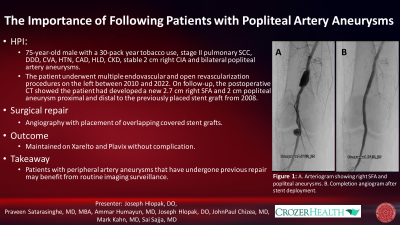Back

Vascular
Category: Quickshot Oral Session 17
Quickshot Oral : Quickshot Oral Session 17
THE IMPORTANCE OF FOLLOWING PATIENTS WITH POPLITEAL ARTERY ANEURYSMS - REDUCING THE RISK OF THROMBOEMBOLIC COMPLICATIONS WITH DIFFERENT SURGICAL APPROACHES
Monday, February 13, 2023
7:00am – 8:00am East Coast USA Time

- JH
Joseph Hlopak, DO
General Surgery Resident
Crozer Health, Delaware, United States - PS
Praveen Satarasinghe, MD, MBA
United States
Presenter(s)
Principal Contact(s)
Objectives: Patient is a 75-year-old active man, history of 30-year pack-per-day tobacco use, stage II squamous cell carcinoma of the left lung status post partial left lobectomy, severe degenerative disc disease with lumbar myelopathy, with a known diagnosis of bilateral popliteal artery aneurysms, common iliac aneurysms, and multiple revascularization procedures.
The patient’s extensive vascular surgical history began in 2008 when he presented with right lower extremity acute limb ischemia secondary to a thrombosed popliteal artery aneurysm; the patient underwent successful thrombolysis and Viabahn stent graft repair. The right lower extremity stent graft had no issues until 2021 when the patient was noted to have additional aneurysms proximal and distal to the stent graft. The patient had right popliteal artery aneurysm repair with two overlapping Viabahn stent grafts.
In contrast to the right leg, the left leg had more issues. In 2010, the patient presented with enlargement of his left popliteal artery aneurysm to 2.8 cm, which was repaired with a Viabahn stent graft. In 2016, the patient presented with acute left lower extremity pain and left popliteal artery stent occlusion, resulting in a left proximal superficial femoral artery (SFA) to below-knee popliteal artery bypass with ipsilateral non-reversed greater saphenous vein for limb salvage. Later that year, the prior bypass occluded, and the patient underwent a left SFA to posterior tibial (PT) PTFE bypass with patch angioplasty of the PT artery. In 2022, the patient underwent several left femoral-PT bypass suction thrombectomies with thrombolysis to re-open the graft and was successfully sent home with clopidogrel in addition to his existing rivaroxaban for anticoagulation.
The patient in this case had patency of his right lower extremity for 13 years with a stent graft. In contrast, the left lower extremity remained patent for 6 years and numerous operations followed. Popliteal artery aneurysms are the most common peripheral artery aneurysm and are associated with aneurysms in the aorta and other peripheral arteries sometimes more than 50% of the time. Additionally, up to 50% of patients will present with acute or chronic ischemia at some point in their clinical course. Patients with popliteal artery aneurysms should be screened for other aneurysms, adequately anticoagulated, and can be treated with both endovascular and open techniques to prevent limb loss.
Methods:
Results:
Conclusion:
The patient’s extensive vascular surgical history began in 2008 when he presented with right lower extremity acute limb ischemia secondary to a thrombosed popliteal artery aneurysm; the patient underwent successful thrombolysis and Viabahn stent graft repair. The right lower extremity stent graft had no issues until 2021 when the patient was noted to have additional aneurysms proximal and distal to the stent graft. The patient had right popliteal artery aneurysm repair with two overlapping Viabahn stent grafts.
In contrast to the right leg, the left leg had more issues. In 2010, the patient presented with enlargement of his left popliteal artery aneurysm to 2.8 cm, which was repaired with a Viabahn stent graft. In 2016, the patient presented with acute left lower extremity pain and left popliteal artery stent occlusion, resulting in a left proximal superficial femoral artery (SFA) to below-knee popliteal artery bypass with ipsilateral non-reversed greater saphenous vein for limb salvage. Later that year, the prior bypass occluded, and the patient underwent a left SFA to posterior tibial (PT) PTFE bypass with patch angioplasty of the PT artery. In 2022, the patient underwent several left femoral-PT bypass suction thrombectomies with thrombolysis to re-open the graft and was successfully sent home with clopidogrel in addition to his existing rivaroxaban for anticoagulation.
The patient in this case had patency of his right lower extremity for 13 years with a stent graft. In contrast, the left lower extremity remained patent for 6 years and numerous operations followed. Popliteal artery aneurysms are the most common peripheral artery aneurysm and are associated with aneurysms in the aorta and other peripheral arteries sometimes more than 50% of the time. Additionally, up to 50% of patients will present with acute or chronic ischemia at some point in their clinical course. Patients with popliteal artery aneurysms should be screened for other aneurysms, adequately anticoagulated, and can be treated with both endovascular and open techniques to prevent limb loss.
Methods:
Results:
Conclusion:

